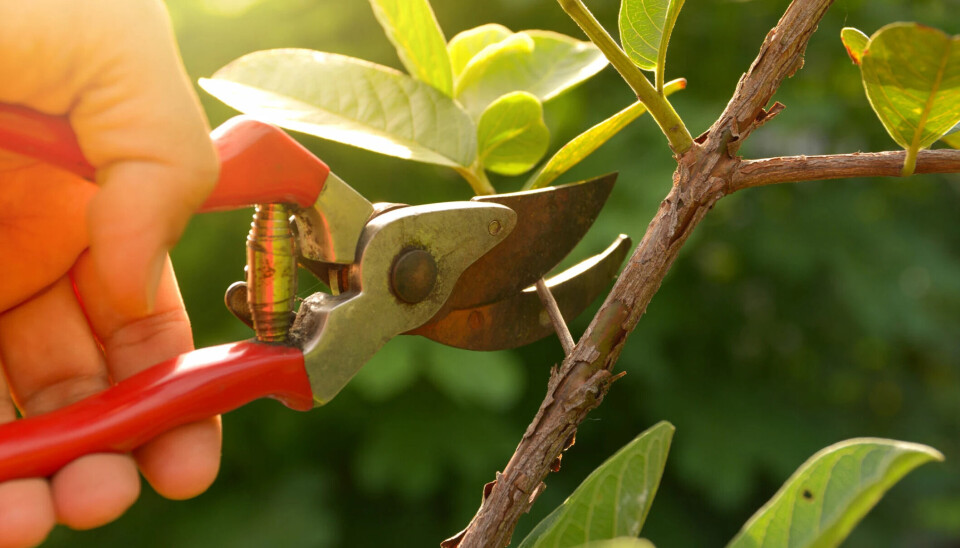
When is the best time to prune bushes and trees?
Summer is not the time to prune bushes and trees, according to researchers. Hobby gardeners often receive different advice.
If you read about pruning on the garden centre Plantasjen's website, it states:
"July, August, and September are good months for pruning most bushes and trees in the garden. The plant is in full growth, and we can see how the plant’s shape looks with foliage."
On the website of Hobbygartnerskolen (the Hobby Gardening School), you will also learn that the so-called JAS period (July, August, September) is a great time for pruning:
"At this time, the plants are in full growth, and they close their wounds quickly. This makes them less susceptible to fungi and other diseases, and it is also easy to shape trees and bushes while they are still full of leaves."
Spread through word of mouth
Several gardeners are familiar with this JAS theory.
However, experts do not consider this to be good advice.
“This knowledge has spread through word of mouth,” Anna Lund says.
She is a researcher at the Swedish University of Agricultural Sciences (SLU) and was interviewed by the Swedish website Exakt (link in Swedish).
The theory is based on the idea that it is wise to prune when the plants contain the maximum amount of energy, according to Lund.
“But in fact, there is rarely a shortage of energy in bushes and trees, so from this perspective, it doesn’t really matter when you prune,” she says.
January is best
Lund and colleagues have tested pruning on various species at different times of the year.
Sweet cherry, linden, maple, and pedunculate oak have been pruned at different times of the year.
The researchers have investigated whether the branches became discoloured at the cut and whether the tree was able to form new branches at the cut.
Their results show that all four species fare best in forming new branches when pruned in January.
As for discolouration, it turned out that linden and oak were significantly less discoloured when pruned in January.
Sweet cherry was least discoloured when pruned in September.
Maple was minimally affected by the time of pruning.
Limit the number of cuts
The researchers observe significant differences between species. However, they know little about what stresses trees when they are pruned, Lund explains in the interview.
“It is exciting that pruning in January yields good results for certain species, as it has been said that trees in dormancy are damaged by pruning,” she says.
It is best to think ahead and minimise the number of cuts made to the tree, she believes.
“By pruning when the tree is young, the cuts can be as small and few as possible,” she says.
“Winter is best”
Endre Bjotveit, an adviser at Norwegian Agricultural Advisory Service, says that it is definitely best to prune while the tree is dormant. That is, in winter.
Pruning during the growing season is not suitable for regular, commercial fruit cultivation, he explains.
An exception may be apple trees.
“If the trees grow too vigorously, it may be wise to remove some upright shoots in the summer to allow light to reach the fruit. This is preferably done in late summer, a few weeks before the expected harvest,” he says.
But this is a bit more of an ‘emergency measure,’ he adds.
Local variations may exist
Bjotveit's colleague Gaute Myren warns that there are local differences in Norway. Eastern Norway is more susceptible to frost problems in winter than Western Norway, for example.
“In January, temperatures can drop to around minus 20°C in Eastern Norway, making it too cold to prune trees. Most pruning in Eastern Norway occurs from mid-February to early April,” he says.
Myren believes that most people in Norway have learned that it is not wise to prune trees in the summer. It used to be more common to prune in early autumn, he thinks.
“Some years, there has been frost so early that the trees have struggled the following year. Therefore, pruning during this time of the year has completely ceased in commercial fruit cultivation,” he says.
More susceptible to diseases
In stone fruit, especially cherries and occasionally plums, large branches sometimes need to be removed in the summer if the tree grows too much, Bjoveit explains.
“Removing some large branches can help the tree allocate more resources,” he says.
But in general, you should leave your pruning shears alone during summer.
If you prune your fruit tree during the summer season, you remove a part of the ‘production system’ that builds up sugar and colour in the fruit, he says.
“It weakens the tree more than if pruning it while it is dormant. The wound is also more susceptible to diseases in the summer. There can be a risk in the winter as well. It is important that the weather is dry when pruning trees,” Bjoveit says.
———
Translated by Alette Bjordal Gjellesvik.
Read the Norwegian version of this article on forskning.no
































